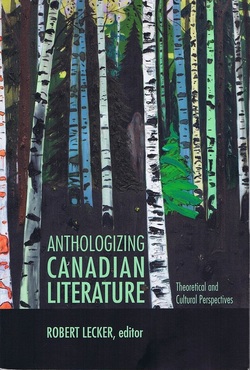
For its editor and most of its contributors the title of this book does not refer to the anthologizing of ‘some’ Canadian literature – although this what Canadian literature anthologies do – or to the anthologizing of parts of Canadian literature, but to the anthologizing of Canadian literature as a national literature. Thus many of the essays quickly make a link between anthologies and canonicity. The editors of Canadian literature anthologies believe they are determining both which Canadian writers can be perceived as writers of ‘official’ Canadian Literature and hence how the Canadian nation is portrayed.
The book is thus a logical project for editor Robert Lecker, whose 2013 book was the remarkably comprehensive study of national Canadian poetry anthologies, Keepers of the Code, and who has also both written and edited essay collections on questions of Canadian canonicity. The links between canonicity and “quality” are slyly raised here by D.M.R. Bentley in his mischievously titled contribution “The Poetry of the Canoe,” an examination of how William Douw Lighthall’s 1889 collection Songs of the Great Dominion was produced. With detailed research and very little commentary Bentley reveals how interweavings of nationalism, nepotism, romantic understandings of quality, and the not unlimited resources of a publisher produced a roster of poets quickly out of date and only selectively remembered in later decades. In the collection’s opening essay, “Anthems and Anthologies,” Richard Cavell had traced the origins of the word “canonical” in Christian doctrine and later links between canonicity and ideology to arrive at the conclusions that any “Canadian national narrative” is “an essentialist discourse that is belied by the multiplicity of nations in Canada,” and that “the anthology must always fail to represent the nation because there is no nation to represent.” Together, the two essays suggest that “anthologizing Canadian literature” – or anthologizing any national literature – may always already be a fragile and dubious accomplishment.
Karis Shearer in “The Poet Editor and the Small Press: Michael Ondaatje and The Long Poem Anthology" notes the exaggerations and misrepresentations that can be part of the framing of a national anthology, and how the anthologized poem may have only an imprecise resemblance to the poem as it was originally published. Her essay suggests that all anthologies designed for academic use to some extent regularize their poems. Lorraine York contributes “Why So Serious: The Quirky Canadian Literature Anthology,” an essay in which she discusses anthologies such as The Blasted Pine, Whale Sounds, 100% Cracked Wheat, Panty Lines, and Desperately Seeking Susans (she omits the more obviously national Love Where the Nights are Long and The Maple Laugh Forever), pointing out how these collections seem designed to be simultaneously serious and non serious, and how they – similarly paradoxically – operate to themselves portray the nation while also parodying establishment projects of such portrayal.
It’s very evident in this collection, although few of the contributors mention it specifically, how the sudden academic recognition of Canadian Literature in the 1970s dramatically changed the publishing field, and readership, of Canadian literature anthologies. Before the 1970s most were trade books or association books, marketed – like Lighthall’s Poems of the Great Dominion – to educated readers of all ages. After the 1970s the largest market for Canadian poetry anthologies had become the university; the vast majority of anthology copies sold were academic books, and their buyers and readers were students 18-23 years of age. To be canonical, a poet had to have written poems suitable for the classroom rather than the fireside – a disadvantage for writers of longer poems. The poems also had to meet the financial parameters of large, often multinational, academic publishers. This shift is made especially clear in Janet Friskney’s contribution “Canadian Literary Anthologies through the Lens of Publishing History.”
I also have an essay here, “Reading Anthologies,” an essay on what may motivate people to read a poetry anthology – or to edit one. There are a lot of poet-editors who have tried to shape the Canadian poetry canon, sometimes attempting also to insert themselves into it, some – Gary Geddes comes to mind – almost single-handedly. (Geddes has an essay here too, interestingly titled “Confessions of an Unrepentent Anthologist.”) I note that there is a difference between readers like myself, who are motivated to read poetry throughout our lives, including that in those quirky national anthologies, and the captive audience of young undergraduates whose industrially produced anthologies of presumably canonical poetry are prescribed by their instructors. Will many of these students become continuing readers of poetry? I also note that the industrially produced anthology, and with it a nationally arguable canon, may itself be about to vanish. The digitized text, and accompanying changes to copyright law, have made the instructor-edited course pack a popular, flexible, and economical alternative to the Bennett and Brown, the Moss and Sugars, the Lecker, or the Geddes. These course-packs leave few traces of their changing contents, and thus little way for anyone to know what similarities there may be at any time among the Canadian 'canons' in Vancouver, Winnipeg, Toronto, Lennoxville, and Antigonish. I like diversity; I also like knowing about it, and its evolving history. Our National Library should be collecting Canadian literature course packs just as it collects the ISBN-numbered books they may be displacing.
FD
 RSS Feed
RSS Feed